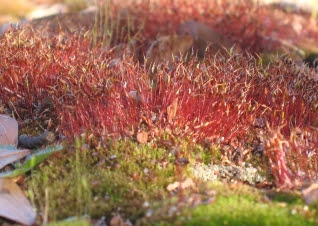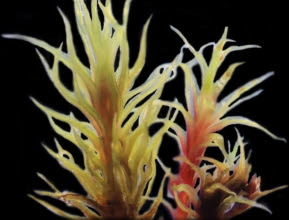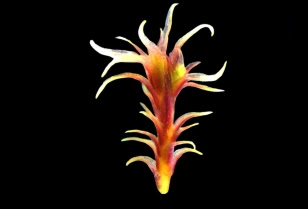Researchers from the HudsonAlpha Institute for Biotechnology were part of a decade-long project to sequence the complete genome of Ceratodon purpureus, a tiny moss with a lot to say about plant evolution. Their findings were recently published in Science Advances.
A short, cosmopolitan moss
 C. purpureus, commonly known as fire moss, grows on every continent across the world. It can withstand conditions that are otherwise unsatisfactory for other plants—growing in soil, rock, wood, old roofs, sand, and cracks of sidewalks. In fact, it was given the moniker ‘fire moss’ because it is often the first organism to recolonize an area after fire destruction.
C. purpureus, commonly known as fire moss, grows on every continent across the world. It can withstand conditions that are otherwise unsatisfactory for other plants—growing in soil, rock, wood, old roofs, sand, and cracks of sidewalks. In fact, it was given the moniker ‘fire moss’ because it is often the first organism to recolonize an area after fire destruction.
Like most mosses, C. purpureus has separate male and female plants, a phenomenon called dioecy. In addition to being dioecious, fire moss is haploid, each individual having only one sex chromosome (U for females and V for males), unlike humans which typically have two (XX for female and XY for male).
Many normal chromosomes (for example, the 22 pairs of non-sex chromosomes in humans) recombine, or mix, so that the genes that a child receives are a mix of genes from their mom and the genes from their dad. This mixing makes new combinations of genes, so no two individuals are genetically alike. The Y chromosome, however, does not mix with the X chromosome, presumably because it is beneficial in an evolutionary sense to keep all of the male genes together.
The Y chromosome in humans and many other mammals is physically tiny and has only a few genes compared to their X counterpart, leading many to believe the lack of mixing leads to gene loss in the Y chromosome. To test this theory, the paper’s first author, HudsonAlpha postdoctoral fellow Sarah Carey, PhD, and her graduate school mentor, University of Florida Associate Professor Stuart McDaniel, PhD, turned to our tiny, cosmopolitan friend the fire moss.
“Fire moss has maintained its dioecy and has specialized in being male or female for a very long time,” says McDaniel. “Another useful feature of the mosses is that the lack of genetic mixing is not restricted to the male chromosome, but is a feature of both sexes. This unusual arrangement allowed us to ask- was it only a lack of genetic mixing that causes sex chromosomes, like the human Y, to lose genes, or was it something else?”
The fire moss genome offered a genomic surprise
To begin studying the fire moss sex chromosomes, the team needed to generate a high-quality genomic sequence assembly for the moss genome. Scientists at HudsonAlpha’s Genome Sequencing Center (GSC), led by co-directors Jane Grimwood, PhD, and Jeremy Schmutz and funded as part of the Department of Energy Joint Genome Institute (JGI), stepped in to contribute their genome sequencing and assembly expertise to the project. Sequencing the complete fire moss genome took over a decade to complete, in part because of complications with the sex chromosomes.
“There are very few high-quality, complete plant genome assemblies that include sex chromosomes,” says Schmutz. “The sex chromosomes are complicated by their many sequence repeats that are hard to assemble from short sequence reads. As technology advanced over the past decade while we were sequencing this genome, we replaced parts of the genomes with newly resolved pieces. PacBio long read sequencing combined with a mapping technique called HiC eventually alllowed us to resolve the complete sex chromosomes.”
Carey, who was a graduate student in McDaniel’s lab at the University of Florida at the time, was shocked when they received the genome data back from the GSC team. The sex chromosomes in fire moss were huge. The team estimates that each of the fire moss sex chromosomes has 3,400 genes, over 30 times more than the human Y chromosome which has less than 100 genes.
“In humans, the Y chromosome is a fraction of the size of the X chromosome presumably because it is losing genes by not mixing genes with the female X chromosome,” says Carey. “Similarly, the extremely large fire moss sex chromosomes do not undergo recombination, but they do not degenerate and lose genes like the human Y. Our work suggests this so-called suppressed recombination is not as clearly linked to gene loss as many previously thought.”
In addition to the large sex chromosomes, the research team also discovered that the fire moss sex chromosomes are at least 300 million years old—older than mammalian sex chromosomes and even older than the dinosaurs. Although they have been around for millions of years, the moss sex chromosomes do not seem to have degenerated like the human Y, further supporting the suggestion that there must be more than just loss of genetic mixing contributing to the tiny human Y chromosome.
What can these giant sex chromosomes teach scientists?
The lack of degeneration on the moss sex chromosomes means that they still have a lot of genes, and many of them have been evolving “maleness” or “femaleness” for a very long time. Many of the genes on the moss sex chromosomes are known to control fertility in flowering plants and crop plants. Control of reproduction in crop plants is potentially very important for food production, and the moss genes may provide new tools to boost female or male linked function.
 As a practical example, only female flowers make fruits in many crops, like melons, squash, strawberries, grapes, and many others. In breeding programs, breeders often use sterile male plants to control the parents of seeds and breed more of the desirable female offspring. The moss sex chromosomes provide a new tool for studying genes that might have economically important sex specific functions which could be key to accelerating breeding programs or increasing yield in important crops.
As a practical example, only female flowers make fruits in many crops, like melons, squash, strawberries, grapes, and many others. In breeding programs, breeders often use sterile male plants to control the parents of seeds and breed more of the desirable female offspring. The moss sex chromosomes provide a new tool for studying genes that might have economically important sex specific functions which could be key to accelerating breeding programs or increasing yield in important crops.
It is remarkable that a plant that seems so simple from the outside has such a complex sex determining system. The HudsonAlpha GSC team and McDaniel’s lab at UF are teaming up again to tackle the genomes of other mosses that have fascinating interaction with microbes and other soil fauna.
Researchers discussed the collaborative project on an episode of JGI’s podcast, Genome Insider. Check out episode 4: The Big Deal About Short Plants.
About HudsonAlpha: HudsonAlpha Institute for Biotechnology is a nonprofit institute dedicated to developing and applying scientific advances to health, agriculture, learning, and commercialization. Opened in 2008, HudsonAlpha’s vision is to leverage the synergy between discovery, education, medicine, and economic development in genomic sciences to improve the human condition around the globe. The HudsonAlpha biotechnology campus consists of 152 acres nestled within Cummings Research Park, the nation’s second largest research park. The state-of-the-art facilities co-locate nonprofit scientific researchers with entrepreneurs and educators. HudsonAlpha has become a national and international leader in genetics and genomics research and biotech education and fosters more than 45 diverse biotech companies on campus. To learn more about HudsonAlpha, visit hudsonalpha.org.

